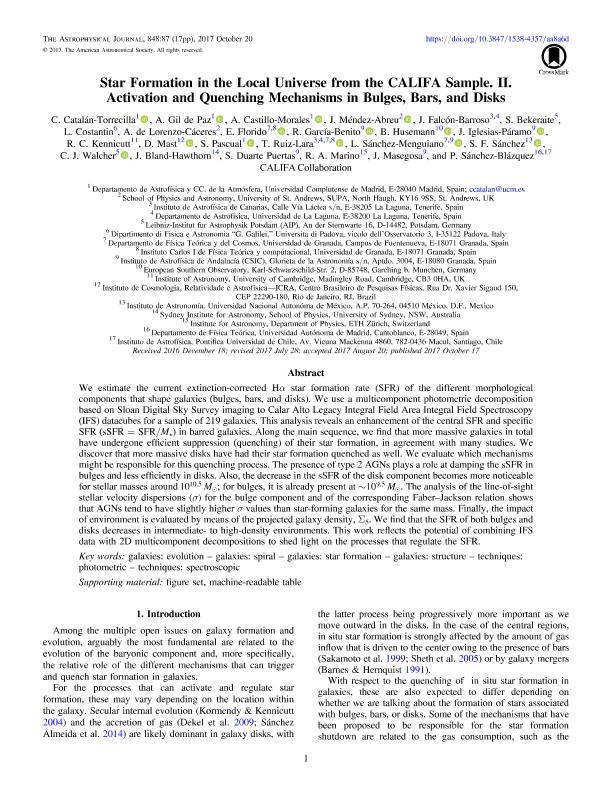Artículo
Star Formation in the Local Universe from the CALIFA Sample. II. Activation and Quenching Mechanisms in Bulges, Bars, and Disks
Catalán-Torrecilla, C.; Gil De Paz, A.; Castillo-Morales, A.; Méndez-Abreu, J.; Falcón-Barroso, J.; Bekeraite, S.; Costantin, L.; Lorenzo-Cáceres, A. De; Florido, E.; García-Benito, R.; Husemann, B.; Iglesias-Páramo, J.; Kennicutt, R.C.; Mast, Damian ; Pascual, S.; Ruiz-Lara, T.; Sánchez-Menguiano, L.; Sánchez, S.F.; Walcher, C.J.; Bland-Hawthorn, J.; Puertas, S. Duarte; Marino, R. A.; Masegosa, J.; Sánchez-Blázquez, P.; Califa Collaboration
; Pascual, S.; Ruiz-Lara, T.; Sánchez-Menguiano, L.; Sánchez, S.F.; Walcher, C.J.; Bland-Hawthorn, J.; Puertas, S. Duarte; Marino, R. A.; Masegosa, J.; Sánchez-Blázquez, P.; Califa Collaboration
 ; Pascual, S.; Ruiz-Lara, T.; Sánchez-Menguiano, L.; Sánchez, S.F.; Walcher, C.J.; Bland-Hawthorn, J.; Puertas, S. Duarte; Marino, R. A.; Masegosa, J.; Sánchez-Blázquez, P.; Califa Collaboration
; Pascual, S.; Ruiz-Lara, T.; Sánchez-Menguiano, L.; Sánchez, S.F.; Walcher, C.J.; Bland-Hawthorn, J.; Puertas, S. Duarte; Marino, R. A.; Masegosa, J.; Sánchez-Blázquez, P.; Califa Collaboration
Fecha de publicación:
10/2017
Editorial:
IOP Publishing
Revista:
Astrophysical Journal
ISSN:
0004-637X
e-ISSN:
1538-4357
Idioma:
Inglés
Tipo de recurso:
Artículo publicado
Clasificación temática:
Resumen
We estimate the current extinction-corrected Hα star formation rate (SFR) of the different morphological components that shape galaxies (bulges, bars, and disks). We use a multicomponent photometric decomposition based on Sloan Digital Sky Survey imaging to Calar Alto Legacy Integral Field Area Integral Field Spectroscopy (IFS) datacubes for a sample of 219 galaxies. This analysis reveals an enhancement of the central SFR and specific SFR (sSFR = SFR/M ∗) in barred galaxies. Along the main sequence, we find that more massive galaxies in total have undergone efficient suppression (quenching) of their star formation, in agreement with many studies. We discover that more massive disks have had their star formation quenched as well. We evaluate which mechanisms might be responsible for this quenching process. The presence of type 2 AGNs plays a role at damping the sSFR in bulges and less efficiently in disks. Also, the decrease in the sSFR of the disk component becomes more noticeable for stellar masses around 1010.5for bulges, it is already present at ∼ 109.5. The analysis of the line-of-sight stellar velocity dispersions (σ) for the bulge component and of the corresponding Faber-Jackson relation shows that AGNs tend to have slightly higher σ values than star-forming galaxies for the same mass. Finally, the impact of environment is evaluated by means of the projected galaxy density, Σ5. We find that the SFR of both bulges and disks decreases in intermediate- to high-density environments. This work reflects the potential of combining IFS data with 2D multicomponent decompositions to shed light on the processes that regulate the SFR.
Archivos asociados
Licencia
Identificadores
Colecciones
Articulos(CCT - CORDOBA)
Articulos de CTRO.CIENTIFICO TECNOL.CONICET - CORDOBA
Articulos de CTRO.CIENTIFICO TECNOL.CONICET - CORDOBA
Citación
Catalán-Torrecilla, C.; Gil De Paz, A.; Castillo-Morales, A.; Méndez-Abreu, J.; Falcón-Barroso, J.; et al.; Star Formation in the Local Universe from the CALIFA Sample. II. Activation and Quenching Mechanisms in Bulges, Bars, and Disks; IOP Publishing; Astrophysical Journal; 848; 2; 10-2017
Compartir
Altmétricas



